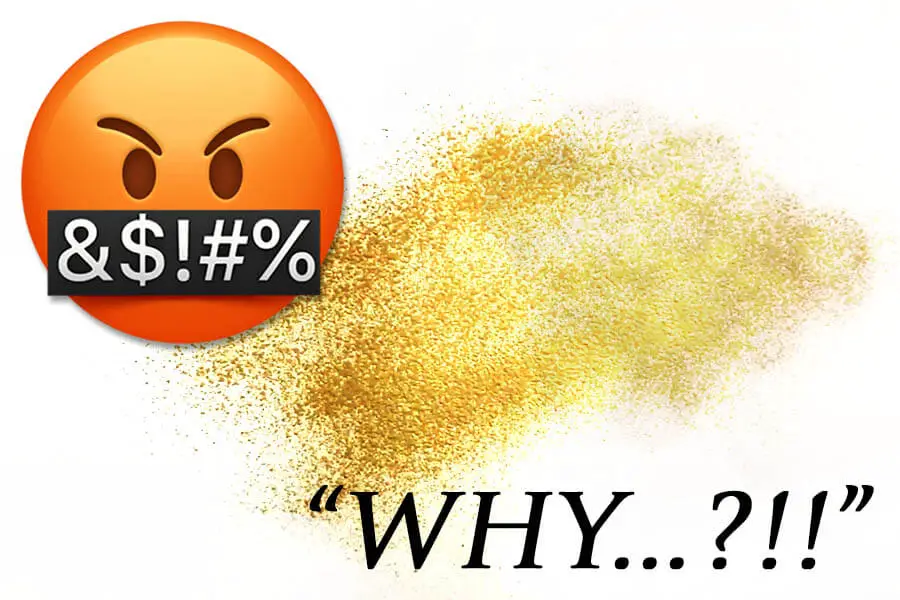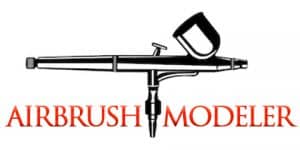
Why Is My Airbrush Spitting And Sputtering
An airbrush spits and sputters due to a number of factors, most commonly incorrect paint thinning ratio and air pressure settings, moisture build-up from the compressor, airbrush damage, and general airbrush upkeep and use.
I’ve experienced this challenge myself, looking down at my equipment and thinking why is my expensive Iwata airbrush spitting…
…little did I realise that it all came down to operator error in one form or another. 🙄
After a lot of research and experimenting with different ‘fixes’ I found the following factors that can cause an airbrush to spit or spatter instead of giving a nice even flow of paint:
Too Low Pressure
If the air pressure coming from your airbrush compressor is too low the airbrush won’t be able to atomise the paint properly, causing it to spatter in little droplets instead of the fine mist of paint that we want.
Paint Not Thinned Enough
If your paint is too thick it won’t atomise properly at a given pressure, and as a result you’ll get spattering paint from the airbrush.
Sure you could increase the pressure and possibly alleviate the problem of paint speckling but additional pressure isn’t always helpful, in fact it could be detrimental in some cases to your paint work, and there are some compressors without the ability to increase the working pressure going to the airbrush.
Not Following Your Spray Paint With A Burst Of Air
This relates to airbrushes with a dual action trigger where the volume of paint sprayed can be adjusted.
When you finish airbrushing there can be a small amount of paint build up around the nozzle and/or tip of the needle.
Press the trigger down so that you get a burst of air but no paint, and this may help to blast off any extra paint that would otherwise dry on the needle and cause problems with the spray pattern next time you use the airbrush.
Airbrush Tip Dry
Airbrush tip dry is when the paint start to rapidly dry before it has left the airbrush and accumulates on the tip of the airbrush needle, and is most common with acrylic paints.
This dried paint can cause problems with the spray pattern that include some level of paint-spits on your job.
Needle Or Nozzle Damage
All kinds of problematic things can happen if you damage the tip of your airbrush needle or nozzle, from wonky paint delivery to inconsistent spray patters, and also to paint spitting and sputtering.
Moisture In The Air Hose
Getting small water droplets in the paint is never good for the quality of your airbrushing and can result in a spattering effect in the spray pattern.
The process of compressing air is such that it can cause water vapor to coalesce into little droplets, but this can be mitigated by the use of a water or moisture trap.
👍 For full details on what an airbrush compressor water trap is and whether you personally need one check out this article on the topic.
Not Emptying Your Water Trap
It’s all good and well to have water trap, it will do an excellent job of pulling the majority of water out of the airstream prior to delivering it to your airbrush, but not emptying the trap of water can also be problematic and there numerous reports of this causing a airbrushed paint to spatter due to water droplets still being present in the paint.
👍 For full details on how to properly empty and also clean your water trap check out this in-depth article!
Fittings Not Tight Enough
If fittings aren’t tight enough it can cause a pressure to ‘escape’ causing a low pressure environment in the airbrush regardless of what the compressor is delivering to the airbrush.
And as we noted in the very first point, too low pressure in your airbrush will cause sub-standard paint atomisation and spitting paint will be the likely result.
How To Stop Your Airbrush From Spitting With Corrective Measures
Here are some measures you can take right now to fix an airbrush that is spitting and sputtering paint, or water, during your current airbrushing session:
AIRBRUSH SPITTING FIX 1
Increase Your Air Pressure
As we learnt earlier, a too low pressure setting can cause a paint sputtering effect from your airbrush.
If you increase the air pressure you’ll get better atomisation of the paint and you may find this is sufficient to remove the spitting effect you’re getting from your airbrush.
AIRBRUSH SPITTING FIX 2
Empty Your Water Trap
First of all, empty your water trap.
There have been numerous reports of people have problems with spitting paint from their airbrush even though have a water trap fitted to their compressor, however all, or at least part, of the problem appears to come down to the water trap being full of water.
They do need emptying regularly and it’s a good idea to do it whenever it’s about a quarter full.
As it becomes more and more full you’ll increase the chance of running into paint spitting problems, so ensuring it’s fully emptied at regular intervals will go a long way towards alleviating the problem.
AIRBRUSH SPITTING FIX 3
Ensure All Fittings Are Tight
Check all of the fittings from your compressor outlet right through to the needle shroud on your airbrush, as any loose fittings or gaps are going to let pressure escape and potentially give you the low pressure problems that can exacerbate paint spitting and sputtering.
Everything that screws on should be double checked to be fairly finger tight, but you don’t need to attack with superman strength of you may end up doing more harm to the fittings than good.
AIRBRUSH SPITTING FIX 4
Thorough Cleaning
If you’re still having the same paint spitting issue after the first three fixes it’s time to give your airbrush a clean.
You don’t need to remove the nozzle at this point, but clean out the paint cup thorough, the front of the needle shroud, and remove the needle itself and clean it perfectly.
Put the airbrush back together and give it another go to see if you’ve cleared out the problem paint that was gumming up the system in some way and causing the paint sputtering and speckling.
How To Stop Your Airbrush From Spitting With Preventative Measures
If the first four corrective measures don’t work it’s time to get out the big guns and check off some of the more preventative type measures to see what the ultimately solution is.
AIRBRUSH SPITTING FIX 5
Proper Deep Cleaning
This is a full deep clean, paint cup (on a gravity feed airbrush), paint tube, remove the needle and nozzle entirely and carefully clean them, and if need be let the nozzle and front of the airbrush sit in thinners or airbrush cleaner to loosen any stubborn paint that could be causing the problem.
This should be the best damn clean you’ve ever done and no stone left unturned.
After all, if you don’t clean it properly you’ll be leaving a question mark over this point for if and when the spitting paint continues.
AIRBRUSH SPITTING FIX 6
Correct Paints
The paint types matter, and if you’re not using a paint that’s anticipated by the manufacturers to be used in an airbrush, then the paint you’re using may not work properly under any circumstances of thinning and air pressure.
Granted, this is likely a rare thing, as properly thinned paint of any type will usually airbrush at least passingly well, but to make sure the paint isn’t the problem you should fall back on a paint you’ve used without any problems in the past and do a test airbrushing session with it to see if you still have the paint speckling and sputtering problem.
If you still have the problem then it’s not the paint, if you don’t have the problem then it was the paint.
AIRBRUSH SPITTING FIX 7
Proper Thinning Ratio And Air Pressure Settings
There is a very strong relationship between the thinning ratio of the paint and the air pressure you airbrush it at.
The thinner the paint, the lower the air pressure you can successfully use (which is almost always a good thing), and vice-versa.
You want to have your paint thinned such that it allows you to airbrush at the lowest possible pressure while still being able to properly cover the work without too much transparency.
If you’re getting paint spitting then you’re either using too low a pressure, which means thin the paint more or increase the pressure.
Getting the correct thinning ratio and air pressure is a process you should test out with every new brand and type of paint you use, and it may be an excellent idea to revisit this process now to see if really nailing it alleviates the paint spitting problem.
👍 For an in-depth article on the process of thinning your paints and getting the correct thinning ratio and air pressure mix, check out this excellent and detailed article on the topic.
The article talks about thinning Tamiya lacquer paints however the process is identical for all paint brands and types. 👍
AIRBRUSH SPITTING FIX 8
Check For Damaged Parts
If, after going through all of the fixes so far, you find that you’re still having a problem with paint spitting out of your airbrush, you may have a damaged airbrush needle or nozzle.
Check out your needle and nozzle under good magnification if possible to see if you can identify any splits, bumps or burrs, a bent tip, or anything that looks untoward.
👍 If you find that your needle has a bent tip you can check out this detailed article which teaches you how to straight and fix the needle and get it functioning near perfectly once more.
AIRBRUSH SPITTING FIX 9
Use A Water Trap On Your Airbrush And/Or Airbrush Compressor
As mentioned towards the start of the article, water droplets in your paint which have been delivered from the compressor can really stuff up your paint work, including causing some level of paint spitting and speckling.
While this may take a little investment and time and your part, a way to alleviate this problem significantly is to install a water trap either on your compressor or at the air inlet of your airbrush.
You have the option to buying and installing a water trap yourself if you have the technical ability to do so, or you can upgrade your compressor to one that comes with a water trap installed out of the factory.
It should be noted that if you airbrush in a part of the world that gets fairly humid at times then a water trap, or a dedicated airbrush compressor that ships with a water trap installed, is going to be an excellent investment for you.
👉 For detailed information on airbrush compressors with water traps and how to find the perfect compressor for your personal requirements, check out this article on what to look for when buying a new compressor.
👉 For in-depth information compressor water traps and whether you really need one or not check out this detailed article on the water or moisture traps and filters.
AIRBRUSH SPITTING FIX 10
Use A Tank On Your Airbrush Compressor
Another way to help pull as much moisture out of the air as possible is to use an airbrush compressor that has an air storage tank installed.
This is, of course, going to require a cash investment, but as noted above if you live in a humid environment then it may be very well worth your while.
The environment inside the tank when the air is compressed helps to keep the air dryer and not allow water droplets to form as easily.
This is a last resort type of solution but could be worth considering depending on the humidity of the environment you’re airbrushing in.
👍 For details on some of the dedicated airbrush compressors available on the market today which have air storage tanks installed, check out his article on choosing the very best airbrush compressor for you personal needs here.
Final Thoughts On Airbrush Spitting Paint
It’s a problem we all have to tackle at some point, and hopefully it’s as simple as adjusting your paint, thinning ratio and air pressure.
But if these tactics don’t fix the problem you’ve got a range of other effective solutions now available to you from this article that should go a long way to getting your airbrush back to spraying perfectly every time, which is exactly my experience. 👊


